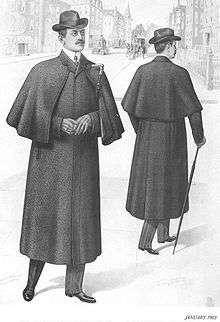Ulster coat
The Ulster is a Victorian working daytime overcoat, with a cape and sleeves.

The Ulster is distinguished from the Inverness by the length of the cape; in the Ulster, this cape only reaches the elbows, allowing free movement of the forearms. It was commonly worn by coachmen who would be seated outdoors in bad weather for long periods, but needed to use their arms to hold reins.
Often made of hard-wearing fabrics, such as herringbones or tweeds, it was not a formal coat at the time, though in the 20th century a cape would be seen as such. After the Edwardian period, it lost its cape, and continued to be used as a heavy-duty overcoat, often in a double-breasted style.
A lightweight version of this coat is called an ulsterette.[1]
In fiction
It is often seen in period productions of Victorian novels, such as those of Charles Dickens and Sir Arthur Conan Doyle. The Ulster coat was referred to in Doyle's Sherlock Holmes novels, A Study in Scarlet, The Sign of the Four, A Scandal in Bohemia, The Adventure of the Blue Carbuncle and The Adventure of the Noble Bachelor. It has become a signifier in a great many late-Victorian costume dramas since.
See also
- Inverness coat
References
- Lewandowski, Elizabeth J. (2011). The Complete Costume Dictionary. Scarecrow Press. p. 304. ISBN 9780810840041.
